 W
WThe Aral barbel is a species of ray-finned fish in the genus Luciobarbus. It is found in the Aral basin, Chu drainage and southern and western Caspian Sea. For spawning, it migrates up to larger tributaries of the western and southern coasts.
 W
WBarilius evezardi is a fish in genus Barilius of the family Cyprinidae. It is found in Maharashtra of India.
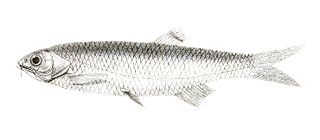 W
WBarilius modestus is a fish in genus Barilius of the family Cyprinidae.
 W
WThe barred conger is a species of conger eel that lives in the tropical western and central Indo-Pacific region. It is also known as the barred sand conger. It is a bottom-dwelling fish and is found in the waters around Madagascar, Indonesia, the Marshall Islands, Hawaii and Tahiti and some other island groups.
 W
WThe blacktop corydoras is a tropical freshwater fish belonging to the subfamily Corydoradinae of the family Callichthyidae. It originates in inland waters in South America, and is found in the Amazon River basin in Ecuador and Northern Peru. It was described by Edward Drinker Cope in 1872.
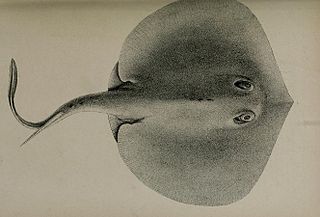 W
WThe thorny round stingray is a species of fish in the family Urotrygonidae. It is found in Chile, Colombia, Costa Rica, Ecuador, El Salvador, Guatemala, Honduras, Mexico, Nicaragua, Panama, and Peru. Its natural habitat is open seas.
 W
WThe Colorado River cutthroat trout is a subspecies of cutthroat trout native only to the Green and Colorado River basins, which are west of the Continental Divide. Cutthroat trout found in other river basins belong to other subspecies.
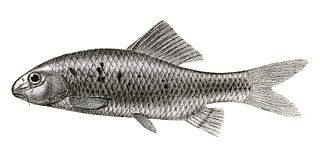 W
WCyprinion watsoni, the Indus lotak, is a species of ray-finned fish in the genus Cyprinion. The original type specimen described as Cyprinion watsoni]] from the Indus and the populations elsewhere which are included by some authorities in C. watsoni are regarded by others as separate species Cypirion muscatensis from Oman and the United Arab Emirates and Cyprinion microphthalmum from Iran, Afghanistan and Pakistan.
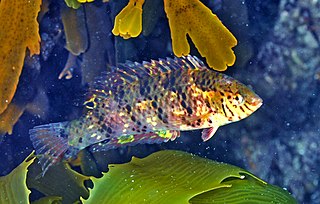 W
WDotalabrus aurantiacus, Castelnau's wrasse, is a species of wrasses native to the Indian Ocean coasts of Australia. It is the type species of its genus. The type locality is Adelaide, St. Vincent Gulf, South Australia.
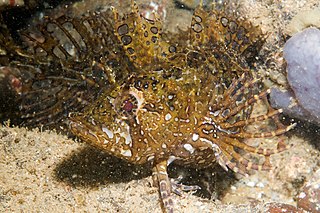 W
WHeteroclinus tristis, the sharp-nose weedfish, is a species of clinid native to the coastal waters of southern Australia where it prefers sandy reefs with sparse vegetation. This species can reach a maximum length of 30 centimetres (12 in) TL. This species feed primarily fishes, shrimp and prawns.
 W
WIndoreonectes evezardi is a species of ray-finned fish in the family Nemacheilidae. Earlier it was known as Nemacheilus evezardi described by Day (1878) captured from a river stream near Pune. It is endemic to India, found in the Western Ghats and the Satpuras. Most populations are found in normal streams, but two distinct cave-adapted forms exist in Kotumsar Cave.
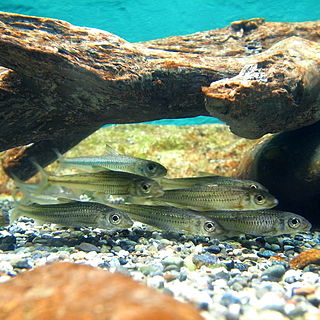 W
WThe Khanka gudgeon is a species of cyprinid, an East Asian freshwater fish that occurs from the Amur basin in Russia, through China, Mongolia and Japan, to Vietnam. It reaches up to 13.6 cm (5.4 in) in total length.
 W
WThe Khanka spiny bitterling is a temperate freshwater fish belonging to the Acheilognathinae subfamily of the family Cyprinidae. It originates in the inland rivers in Asia, and is found in China, Korea, and Russia. It is currently the only known species in its genus.
 W
WThe king dory or lookdown dory is a dory, in the genus Cyttus, found around South Africa, southern Australia, and New Zealand, over the continental shelf at depths of between 200 and 800 m. Its length is between 20 and 40 cm.
 W
WLatridopsis forsteri, the bastard trumpeter or copper moki, is a species of trumpeter native to the eastern Indian Ocean and southwestern Pacific Ocean around Australia(Robe, South Australia, to Sydney, New South Wales, and around Tasmania) and New Zealand. This species is found at depths of from 20 to 160 metres over the continental shelf. It can reach a length of 65 centimetres (26 in) TL. This species is commercially important.
 W
WNannostomus beckfordi,, commonly known as the golden pencil fish or Beckford's pencil fish, is a freshwater species of fish belonging to the characin family Lebiasinidae. It occurs widely and commonly in swamps and slow-moving waters in Brazil, Guyana, French Guiana, and Suriname.
 W
WTetronarce fairchildi, commonly known as the New Zealand torpedo, is a species of electric ray of the family Torpedinidae found only around New Zealand, at depths of between 5 and 1,100 m. This species is placed in the genus Tetronarce.
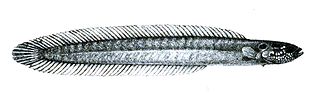 W
WThe ocellate eel blenny is a species of ray-finned fish from the subfamily Congrogadidae, which is in the family Pseudochromidae. It is the only species in the monospecific genus Blennodesmus. It is found along the northern coasts of Australia, from Western Australia, along the coast of the Northern Territory to Queensland. The ocellate eel blenny is found among coral rubble and occurs in intertidal pools up to a depth of 3 metres (9.8 ft) where it feeds mostly on crustaceans. Like other species of Congrogadid the ocellate eel blenny has eggs covered in hooks, cross shaped hooks in this species. This species has an extremely elongated body, its gill membranes are joineded to the isthmus ventrally. It has one, short lateral line which runs from its shoulder to underneath the front part of the dorsal fin. The body is dark brown in colour with mottled with paler markings and it has a black eyespot, smaller than its eye, located above the opercle. It grows to a maximum length of 8.9 centimetres (3.5 in) standard length.
 W
WOlyra burmanica is a species of longtail catfish endemic to Myanmar where it is found in Pegu Yomas. This species grows to 11 cm (4.3 in) in total length.
 W
WThe Pacific redfin is a species of fish in the family Cyprinidae. It is found from the Siberian Pacific Coast through coastal Japan.
 W
WThe large-scale loach is a species of true loach that is native to Mainland China, Hainan, Taiwan, Korea, and the Russian Far East. It can be found in water bodies such as the Yangtze Basin, Pearl River, Amur River, and various other drainages. There are several known invasive populations in places such as Barcelona, the San Joaquin River in California, and the majority of Japan. The large-scale loach is typically brown, grey, or golden in color with mottled or speckled black dots, which leads to it sometimes called a "peppered loach" when sold at pet stores. It is a small loach, growing between 7.3 to 15.4 cm TL.
 W
WParapercis alboguttata, the bluenose grubfish, known also as the bluenose sandperch and whitespot sandsmelt, is a species of marine bony fish in the family Pinguipedidae, native to the western Indo-Pacific Ocean. It was first described by the German-born, British ichthyologist and zoologist, Albert Günther, in 1872.
 W
WParequula melbournensis, the silverbelly, Melbourne silver biddy or silver biddy, is a species of fish in the family Garreidae, the mojarras. The species was first described by Francis de Laporte de Castelnau in 1872. It is the only member of the monotypic genus Parequula erected by Franz Steindachner in 1879. It is native to the coastal waters of southern Australia at depths from 3 to 100 m. This species can reach 22 cm (8.7 in) in total length.
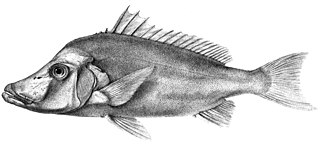 W
WParistiopterus labiosus, the giant boarfish, is a species of armorhead native to the coastal waters of southern Australia, and New Zealand. It occurs over the continental shelf at depths from 20 to 200 m. This species can reach a length of 100 cm (39 in). It is a commercially important species.
 W
WPhysopyxis lyra is a species of thorny catfish found in the Essequibo and Amazon basins. It occurs in the countries of Brazil, Colombia, Guyana and Peru. This species grows to a length of 3.5 centimetres (1.4 in) SL. This species prefers to live amongst submerged organic debris.
 W
WThe Punjab razorbelly minnow is a species of ray-finned fish in the genus Salmostoma.
 W
WPuntius waageni is a species of ray-finned fish in the genus Puntius. This species is endemic to Pakistan.
 W
WThe New Zealand red moki or Australian banded morwong, Cheilodactylus spectabilis, is a morwong, a species of fish found off southern Australia and the North Island of New Zealand from depths to 50 m. Although traditionally included in the genus Cheilodactylus in family Cheilodactylidae, based on genetic and morphological analyses it belongs in the genus Chirodactylus in family Latridae.
 W
WRhycherus filamentosus, commonly known as the tasselled anglerfish, is a species of frogfish endemic to southern Australia in the southwestern Pacific Ocean and southeastern Indian Ocean. It is a well-camouflaged predator and lies in wait on the seabed for unwary prey to approach too close.
 W
WThe Rio Grande chub is a cyprinid fish endemic to the United States. It inhabits the upper Rio Grandeand Pecos River systems in Colorado, New Mexico and Texas. The Rio Grande Chub is native to most of its current range including all three of the states it can be found in. There are non-native populations that currently inhabit Coyote Creek, the Mora River, the Sapello River and other areas in New Mexico. There are currently no studies showing how the Rio Grande Chub is impacting waterways in its non-native range. It has also been proposed that this fish is native to the Canadian River in New Mexico but this has not been proven. It is possible it was introduced there. Natural hybridization can occur between the Rio Grande Chub and the Longnose Dance(Rhinichthys cataractae).
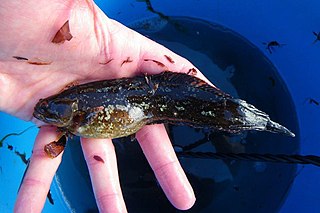 W
WThe short-tassel weedfish is a species of clinid native to the Pacific Ocean waters around New Zealand and Australia. This species are known to feed on fishes and benthic crustaceans. It is the only species in its genus. Klunzinger's name, Clinus marmoratus, is a homonym and was preoccupied by Castelnau's Clinus marmoratus, rendering it invalid for this fish and this name is now considered to be a junior synonym of Cologrammus flavescens.
 W
WThe southern bluefin tuna is a tuna of the family Scombridae found in open southern Hemisphere waters of all the world's oceans mainly between 30°S and 50°S, to nearly 60°S. At up to 2.5 metres (8.2 ft) and weighing up to 260 kilograms (570 lb), it is among the larger bony fishes.
 W
WThe spotted corydoras, longnose corydoras or Agassiz's catfish is a tropical freshwater fish belonging to the subfamily Corydoradinae of the family Callichthyidae. It originates in inland waters in South America, and is found in the upper Amazon River basin in Brazil, Colombia and Peru.
 W
WThe Syr Darya sturgeon is a species of fish in the family Acipenseridae. It is found in Kazakhstan, Tajikistan and Uzbekistan, where it is endemic to the Syr Darya River and, before its drainage, the Aral Sea. Due to the loss of its breeding site and damming projects over the length of the river, it is currently considered Critically Endangered and likely extinct, as no sightings have been reported since 1960. The sturgeon is among the 25 “most wanted lost” species that are the focus of Global Wildlife Conservation's “Search for Lost Species” initiative.
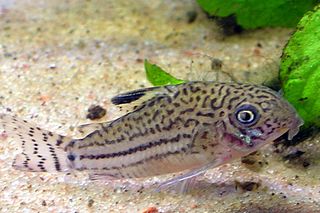 W
WThe three stripe corydoras, leopard catfish, false julii corydoras, or three line catfish is a tropical freshwater fish belonging to the subfamily Corydoradinae of the family Callichthyidae. It originates in inland waters in South America, and is found in the central Amazon River basin in Brazil and Colombia, Peruvian Amazon and coastal rivers in Suriname.
 W
WNeopataecus waterhousii, the whiskered prowfish, is a species of Australian prowfish endemic to the coastal waters of southern and western Australia. This species grows to a length of 19 centimetres (7.5 in) TL. This species is the only known member of its genus.